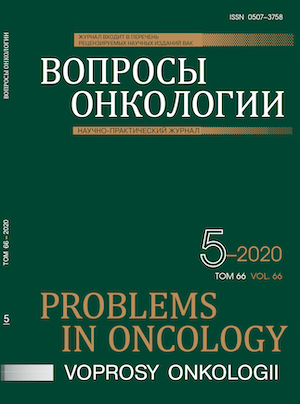Аннотация
Рецессивный дистрофический буллезный эпидермолиз - орфанное наследственное заболевание кожи, обусловленное мутациями в гене COL7A1, кодирующем коллаген VII типа - основной белок якорных фибрилл, обеспечивающих поддержание связи эпидермиса и дермы. Характерный клинический признак рецессивного дистрофического буллезного эпидермолиза - длительно незаживающие раны, на месте которых развивается плоскоклеточный рак кожи. Плоскоклеточный рак кожи при рецессивном дистрофическом буллезном эпидермолизе характеризуется манифестацией в молодом возрасте, агрессивным течением, быстрым ростом и ранней смертностью. В статье представлено клиническое наблюдение 2 больных плоскоклеточным раком кожи, развившемся на фоне рецессивного дистрофического буллезного эпидермолиза.Библиографические ссылки
Fine J.D., Bruckner-Tuderman L., Eady R.A. et al. Inherited epidermolysis bullosa: updated recommendations on diagnosis and classification. J Am Acad Dermatol 2014; 70 (6): 1103-1126. doi: 10.1016/j.jaad.2014.01.903.
Chung H.J., Uitto J. Type VII collagen: the anchoring fibril protein at fault in dystrophic epidermolysis bullosa. Dermatol Clin. 2010; 28 (1): 93-105. doi: 10.1016/j. det.2009.10.011
Watanabe M., Natsuga K., Shinkuma S., Shimizu H. Epidermal aspects of type VII collagen: implications for dystrophic epidermolysis bullosa and epidermolysis bullosa acquisita. J Dermatol. 2018; 45 (5): 515-521. doi: 10.1111/1346-8138.14222.
Кубанов А.А., Карамова А.Э., Альбанова В.И. и др. Врожденный буллезный эпидермолиз: особенности регенерации эпидермиса и методы терапии. Вестник дерматологии и венерологии 2017; (4): 28-37.
Eming S.A., Martin P., Tomic-Canic M. Wound repair and regeneration: mechanisms, signaling, and translation. Sci Transl Med 2014, 6 (265): 265sr6. doi: 10.1126/scitrans-lmed.3009337.
Cianfarani F., Zambruno G., Castiglia D., Odorisio T. Pathomechanisms of altered wound healing in recessive dystrophic epidermolysis bullosa. Am. J. Pathol. 2017; 187 (7): 1445-1453. doi: 10.1016/j.ajpath.2017.03.003.
Nystram A., Bruckner-Tuderman L. Injury- and inflammation-driven skin fibrosis: the paradigm of epidermolysis bullosa. Matrix Biol. 2018; 68-69: 547-560. doi: 10.1016/j.matbio.2018.01.016.
Guerra L., Odorisio T, Zambruno G., Castiglia D. Stromal microenvironment in type VII collagen-deficient skin: the ground for squamous cell carcinoma development. Matrix Biol. 2017; 63: 1-10. doi: 10.1016/j.matbio.2017.01.002.
Kawasaki H., Sawamura D., Iwao F. et al. Squamous cell carcinoma developing in a 12-year old boy with non-Hallopeau-Siemens recessive dystrophic epidermolysis bullosa. Br J Dermatol. 2003; 148 (5): 1047-1050. doi: 10.1046/j.1365-2133.2003.05270.x.
Fine J.D., Johnson L.B., Weiner M. et al. Epidermolysis bullosa and the risk of life-threatening cancers: The National EB Registry experience, 1986-2006. J. Am. Acad. Dermatol. 2009; 60 (2): 203-211. doi: 10.1016/j. jaad.2008.09.035.
Venables Z.C., Nijsten T., Wong K.F. et al. Epidemiology of basal and cutaneous squamous cell carcinoma in the U.K. 2013-15: A cohort study. Br. J. Dermatol. 2019; 181 (3): 474-482. doi: 10.1111/bjd.17873.
Que S.K., Zwald F.O., Schmults C.D. Cutaneous squamous cell carcinoma: Incidence, risk factors, diagnosis, and staging. J. Am. Acad. Dermatol. 2018; 78 (2): 237247. doi: 10.1016/j.jaad.2017.08.059.
Stang A., Khil L., Kajuter H. et al. Incidence and mortality for cutaneous squamous cell carcinoma: comparison across three continents. J Eur Acad Dermatol Venereol. 2019; 33 Suppl 8: 6-10. doi: 10.1111/jdv.15967.
Беляев А.М., Прохоров Г.Г., Раджабова З.А., Байкалова О.И. Обзор современных методов лечения плоскоклеточного рака кожи. Вопросы онкологии. 2019; 65 (1): 7-15.
Condorelli A.G., Dellambra E., Logli E. et al. Epidermolysis bullosa-associated squamous cell carcinoma: from pathogenesis to therapeutic perspectives. Int J Mol Sci. 2019; 20 (22): 5707. doi: 10.3390/ijms20225707.
Mellerio J.E., Robertson S.J., Bernardis C. et al. Management of cutaneous squamous cell carcinoma in patients with epidermolysis bullosa: Best clinical practice guidelines. Br. J. Dermatol. 2016; 174 (1): 56-67. doi: 10.1111/ bjd.14104.
Карамова А.Э., Чикин В.В., Альбанова В.И. и др. Плоскоклеточный рак кожи, развившийся у больной рецессивным дистрофическим буллезным эпидермолизом. Вестник дерматологии и венерологии. 2016; (3): 83-89.
Кубанов А.А., Карамова А.Э., Чикин В.В., и др. Эпидемиология и состояние оказания медицинской помощи больным врожденным буллезным эпидермолизом в Российской Федерации. Вестник Российской академии медицинских наук. 2018; 73 (6): 420-430.
19. Kelly-Mancuso G., Kopelan B., Azizkhan R.G., Lucky A.W. Junctional Epidermolysis Bullosa Incidence and Survival: 5-Year Experience of the Dystrophic Epidermolysis Bullosa Research Association of America (DebRA) Nurse Educator, 2007 to 2011. Pediatr Dermatol 2013; 31 (2): 159-162. doi: 10.1111/pde.12157.

Это произведение доступно по лицензии Creative Commons «Attribution-NonCommercial-NoDerivatives» («Атрибуция — Некоммерческое использование — Без производных произведений») 4.0 Всемирная.
© АННМО «Вопросы онкологии», Copyright (c) 2020
